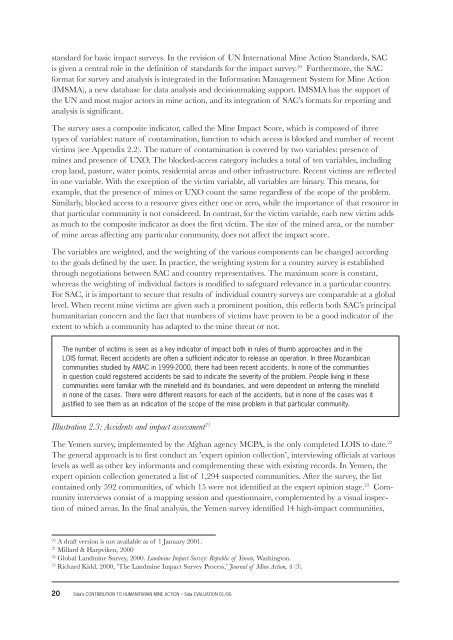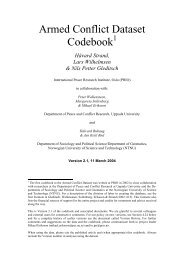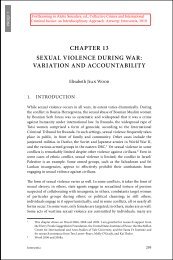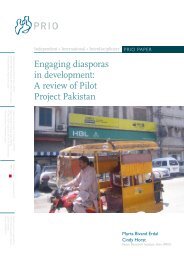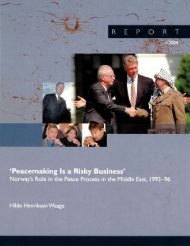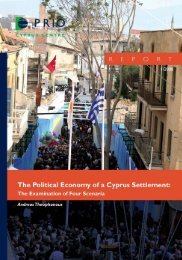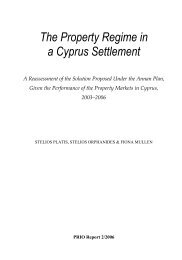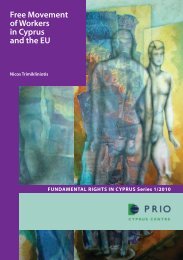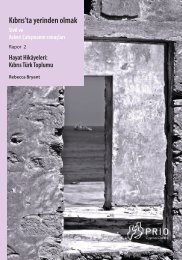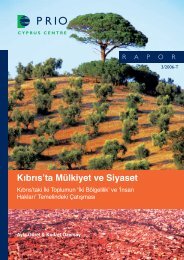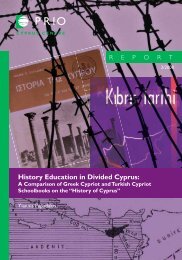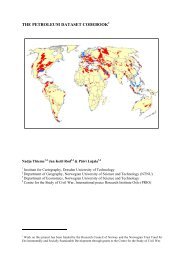standard for basic impact surveys. In the revision of UN International <strong>Mine</strong> <strong>Action</strong> Standards, SACis given a central role in the definition of standards for the impact survey. 20 Furthermore, the SACformat for survey and analysis is integrated in the Information Management System for <strong>Mine</strong> <strong>Action</strong>(IMSMA), a new database for data analysis and decisionmaking support. IMSMA has the support ofthe UN and most major ac<strong>to</strong>rs in mine action, and its integration of SAC’s formats for reporting andanalysis is significant.The survey uses a composite indica<strong>to</strong>r, called the <strong>Mine</strong> Impact Score, which is composed of threetypes of variables: nature of contamination, function <strong>to</strong> which access is blocked and number of recentvictims (see Appendix 2.2). The nature of contamination is covered by two variables: presence ofmines and presence of UXO. The blocked-access category includes a <strong>to</strong>tal of ten variables, includingcrop land, pasture, water points, residential areas and other infrastructure. Recent victims are reflectedin one variable. With the exception of the victim variable, all variables are binary. This means, forexample, that the presence of mines or UXO count the same regardless of the scope of the problem.Similarly, blocked access <strong>to</strong> a resource gives either one or zero, while the importance of that resource inthat particular community is not considered. In contrast, for the victim variable, each new victim addsas much <strong>to</strong> the composite indica<strong>to</strong>r as does the first victim. The size of the mined area, or the numberof mine areas affecting any particular community, does not affect the impact score.The variables are weighted, and the weighting of the various components can be changed according<strong>to</strong> the goals defined by the user. In practice, the weighting system for a country survey is establishedthrough negotiations between SAC and country representatives. The maximum score is constant,whereas the weighting of individual fac<strong>to</strong>rs is modified <strong>to</strong> safeguard relevance in a particular country.For SAC, it is important <strong>to</strong> secure that results of individual country surveys are comparable at a globallevel. When recent mine victims are given such a prominent position, this reflects both SAC’s principalhumanitarian concern and the fact that numbers of victims have proven <strong>to</strong> be a good indica<strong>to</strong>r of theextent <strong>to</strong> which a community has adapted <strong>to</strong> the mine threat or not.The number of victims is seen as a key indica<strong>to</strong>r of impact both in rules of thumb approaches and in theLOIS format. Recent accidents are often a sufficient indica<strong>to</strong>r <strong>to</strong> release an operation. In three Mozambicancommunities studied by AMAC in 1999-2000, there had been recent accidents. In none of the communitiesin question could registered accidents be said <strong>to</strong> indicate the severity of the problem. People living in thesecommunities were familiar with the minefield and its boundaries, and were dependent on entering the minefieldin none of the cases. There were different reasons for each of the accidents, but in none of the cases was itjustified <strong>to</strong> see them as an indication of the scope of the mine problem in that particular community.Illustration 2.3: Accidents and impact assessment 21The Yemen survey, implemented by the Afghan agency MCPA, is the only completed LOIS <strong>to</strong> date. 22The general approach is <strong>to</strong> first conduct an ’expert opinion collection’, interviewing officials at variouslevels as well as other key informants and complementing these with existing records. In Yemen, theexpert opinion collection generated a list of 1,294 suspected communities. After the survey, the listcontained only 592 communities, of which 15 were not identified at the expert opinion stage. 23 Communityinterviews consist of a mapping session and questionnaire, complemented by a visual inspectionof mined areas. In the final analysis, the Yemen survey identified 14 high-impact communities,20A draft version is not available as of 1 January 2001.21Millard & Harpviken, 200022Global Landmine Survey, 2000. Landmine Impact Survey: Republic of Yemen, Washing<strong>to</strong>n.23Richard Kidd, 2000, ’The Landmine Impact Survey Process,’ Journal of <strong>Mine</strong> <strong>Action</strong>, 4 (3).20 Sida’s CONTRIBUTION TO HUMANITARIAN MINE ACTION – Sida EVALUATION 01/06
84 moderate-impact and 494 light-impact ones. Examples of general findings are that blocked access<strong>to</strong> water sources is particularly dangerous and that categories of people likely <strong>to</strong> be subject <strong>to</strong> incidentsinclude people taking lives<strong>to</strong>ck for grazing and risk-taking young males. This illustrates the moregeneral point that LOIS is designed <strong>to</strong> inform not only demining, but also a broader range of HMAactivities, including mine awareness. 24In Mozambique, the Canadian International Demining Institute (CIDC) is in the process of implementinga LOIS, with completion planned for mid-2001. CIDC does not operate as a subcontrac<strong>to</strong>r <strong>to</strong>SAC, but has been using modified versions of SAC instruments. Since HMA in Mozambique has sofar been conducted in the absence of any country-wide level one survey, and with very little impactdata, it is expected that the CIDC survey will represent fundamental improvements in the HMA effort.By itself, it will be of great value in generating a clearer picture of the scope of Mozambique’s mineproblem, an issue that has warranted a lot of discussion over the past few years.Afghanistan has a level one survey. The problem is that the survey has very little impact data, and theresults are in many cases outdated. Following an SAC advance mission in May 2000, SAC suggested thatexisting data be imported in<strong>to</strong> the IMSMA database, complemented by the findings from a modifiedversion of LOIS. However, both tasks are labour demanding, and discussions are ongoing as <strong>to</strong> whetherthe complementary survey should be arranged as a concentrated exercise in which all mine-affectedcommunities are revisited or if one should conduct the impact survey step-by-step, over several years.Only the former option can satisfy the programme’s need <strong>to</strong> become more strongly impact-based in itsplanning. The latter will not give the programme impact data on all tasks, and, in practice, survey willfollow preliminary priorities, which again would have <strong>to</strong> be based on existing data. Given the scope of theAfghan mine problem, the value of having impact data at the national level justifies the costs.One weakness with the LOIS is that it tends <strong>to</strong> rank highly those communities that have a wide range of impacts,even if none of these are particularly dramatic. This relates directly <strong>to</strong> the fact that most of the variables arebinary - the score is either zero or one. Cases in Mozambique serve <strong>to</strong> illustrate this point. In many communitieswhere land is mined, people have taken up cultivation of fields further away from the settlement, and, in someof these cases, the new land is more fertile. In these cases, it seems unlikely that the mined area would becultivated after demining. Nonetheless, in a system such as LOIS, the community would receive the same pointsfor blocked access <strong>to</strong> agricultural areas as those communities in which people have no alternatives.Illustration 2.4: Alternatives <strong>to</strong> resources <strong>to</strong> which access is blocked 25In conclusion, it is significant <strong>to</strong> note that SAC’s composite indica<strong>to</strong>r has become the basic referencefor basic-impact surveys. In terms of including local stakeholders, the survey applies a rapid participa<strong>to</strong>ryappraisal technique that ensures a level of local ownership, and thus legitimacy for the survey. Thesurvey spans all levels, with the community as its primary level of analysis, while ultimately maintainingits ambition <strong>to</strong> have comparable data at the global level. The composite indica<strong>to</strong>r has been developed<strong>to</strong> fill the needs of a basic-impact survey, and is in most cases not a sufficient basis for launchingan operation in a selected community. Hence, the survey is relevant primarily in the earliest phase.Many, particularly proponents of cost-benefit analysis, would argue that the survey has a weakness innot reflecting costs (or constraints) in its impact measure. The SAC format is appropriate for impactassessment at all stages of the emergency-development continuum.24Justin Brady, 2000. 'The Utilization of Level One Survey Data for <strong>Mine</strong> Awareness,’ Journal of <strong>Mine</strong> <strong>Action</strong> 4 (3).25Information based on community study in Millard & Harpviken, 2000, Chapter 6, note 6 above.Sida’s CONTRIBUTION TO HUMANITARIAN MINE ACTION – Sida EVALUATION 01/06 21
- Page 4: This report is part of Sida Evaluat
- Page 9 and 10: MDDMEDDSMGMMLSWMoPHMOUMPLANATONDING
- Page 12 and 13: the conclusions of this report is t
- Page 14 and 15: A prime concern with Mine Action Ce
- Page 16 and 17: 3. The coordination of mine action,
- Page 18 and 19: an needs and the needs of victims o
- Page 20 and 21: At the same time as Sida has been o
- Page 22 and 23: er, throughout the data collection,
- Page 24 and 25: Donors may feel that the costs of i
- Page 26 and 27: is genuinely new. 8 At an overall l
- Page 28 and 29: The first attempt to apply a form o
- Page 32 and 33: Community studiesCommunity studies
- Page 34 and 35: and progress monitored in all phase
- Page 36 and 37: 3 Implementation ChannelsOver the p
- Page 38 and 39: cal implementation and management,
- Page 40 and 41: ing that demining has any effect at
- Page 42 and 43: actual response. In an effort to ov
- Page 44 and 45: ecently developed. The approaches t
- Page 46 and 47: A different tool that will be used
- Page 48 and 49: Alternative implementation channels
- Page 50 and 51: appear to have been doing a good jo
- Page 52 and 53: Coordination may at times even be c
- Page 54 and 55: itarian and development effort. Imp
- Page 56 and 57: Two). In terms of coordinating mine
- Page 58 and 59: ased demining of AREA. Another type
- Page 60 and 61: The Kosovo UNMACC took a number of
- Page 62 and 63: would be accredited and tasked by U
- Page 64 and 65: programme. The proposal was backed
- Page 66 and 67: The present landscape of Swedish ac
- Page 68 and 69: demining purposes. Buoyed by a wave
- Page 70 and 71: given that SRSA also recruits perso
- Page 72 and 73: teams. The need for a breeding capa
- Page 74 and 75: 6 RecommendationsIn the preceding c
- Page 76 and 77: • MACs should operate with agreem
- Page 78 and 79: 7 ConclusionIn this report, we have
- Page 80:
70Appendix 1
- Page 89 and 90:
Ziauddin Operations Officer METADup
- Page 91 and 92:
Bennedich, Claes Department for eva
- Page 93 and 94:
Appendix 3BIBLIOGRAPHYAccelerated D
- Page 95 and 96:
Faulkner, F. & L Pettiford, 1998.
- Page 97 and 98:
McGrath, Rae, 2000. Landmines and U
- Page 99 and 100:
Miscellaneous DocumentsBrady, Justi
- Page 101 and 102:
Appendix 4Sida’s CONTRIBUTION TO
- Page 103 and 104:
Appendix 6• The area must be secu
- Page 105 and 106:
Appendix 7Locality identifier: Dist
- Page 107:
Recent Sida Evaluations00/37:1 Asse


